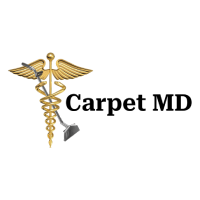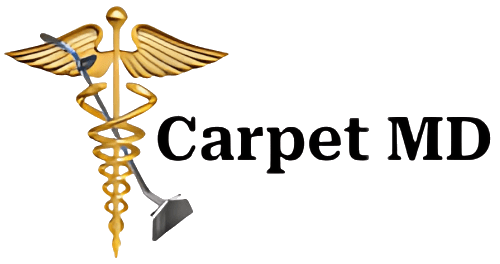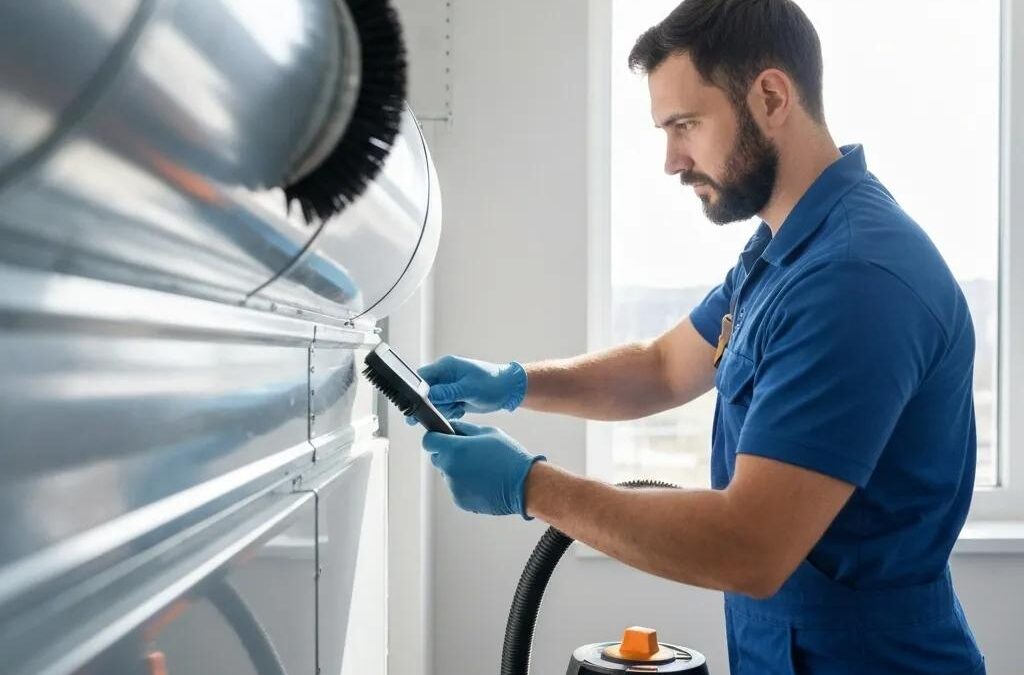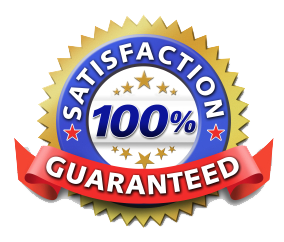Professional air duct cleaning directly removes airborne pollutants from HVAC ductwork, restoring fresh airflow and reducing mechanical strain on heating and cooling equipment for measurable energy savings. By targeting accumulated dust, mold spores, pet dander, and other contaminants, this service boosts indoor air quality while lowering utility bills.
In this guide, you’ll discover what air duct cleaning entails, how it optimizes HVAC performance, the health advantages for your family, when to schedule a service, related dryer vent cleaning benefits, comparisons to other home cleaning services, common concerns addressed, action steps to maximize results, and tips on finding trusted local providers.
What Is Air Duct Cleaning and How Does It Improve Indoor Air Quality?
Air duct cleaning is a specialized process that clears HVAC ductwork of accumulated pollutants, enabling ventilation systems to deliver cleaner air throughout your home. By mechanically agitating and vacuum-removing dust, biological growth, and debris, professional technicians restore optimal airflow and prevent recirculation of allergens. This thorough removal mechanism immediately translates to fewer airborne irritants, reduced odors, and enhanced respiratory comfort for every occupant.
Research indicates that air duct cleaning can significantly reduce the concentration of indoor allergens, such as dust mites and pet dander, improving respiratory health and overall comfort for occupants. This supports the article’s claims about the health benefits of clean air ducts.
What Does Professional Air Duct Cleaning Involve?
Professional air duct cleaning involves a multi-step protocol that includes inspection, agitation, negative-pressure extraction, and post-clean inspection to ensure complete contaminant removal.
- Pre-inspection: Technicians evaluate duct layout and identify high-risk zones.
- Seal and Protect: Registers and vents are covered to contain debris.
- Agitation: Brushes, air whips, and compressed air dislodge settled dust and microbial growth.
- Negative-Pressure Extraction: A powerful industrial vacuum creates suction at the main return to pull out contaminants.
- Final Assessment: Visual or camera inspection confirms debris has been removed before restoring vents.
This structured service ensures all parts of your HVAC system—from supply ducts to plenums—are free of blockages, preparing the system for the enhanced energy benefits discussed next.
How Does Air Duct Cleaning Remove Allergens, Dust, and Mold?
Air duct cleaning reduces indoor allergens by targeting three key contaminants:
- Dust and Dust Mites: High-strength vacuums extract fine particulates clinging to duct walls.
- Pet Dander: Agitation tools dislodge hair and dander, preventing recirculation.
- Mold Spores: Specialized antimicrobial treatments neutralize microbial colonies.
Through a combination of mechanical and chemical treatments, this process interrupts allergen cycles, leading to tangible relief for allergy sufferers. Eliminating these irritants sets the stage for discussing the broader health impacts of clean indoor air.
Why Is Indoor Air Quality Important for Health and Comfort?
Indoor air quality (IAQ) represents the cleanliness and safety of the air you breathe inside, directly impacting respiratory health, cognitive function, and overall comfort. Pollutant removal promotes better sleep, reduces headaches, and limits long-term risks such as asthma exacerbation and chronic respiratory conditions. A healthier IAQ environment also enhances mental clarity and productivity by preventing the cognitive sluggishness that accompanies elevated dust and bioaerosol levels. Understanding IAQ’s importance underscores why routine air duct cleaning is an investment in well-being.
How Does Air Duct Cleaning Enhance HVAC System Energy Efficiency?
Professional duct cleaning enhances HVAC energy efficiency by restoring unobstructed airflow, reducing system workload, and preventing energy loss due to blockages. When ducts are clear, the system circulates air with less resistance, requiring fewer kilowatt-hours to maintain comfortable temperatures. Improved airflow directly translates into lower compressor and motor effort, leading to quantifiable utility savings and reduced wear on critical components.
Before examining specific advantages, the following table compares key energy-related attributes before and after cleaning:
Clean ducts elevate operational performance and prepare your system for long-term cost savings, as detailed in the next sections.
How Does Cleaning Optimize Airflow in HVAC Systems?
By clearing dust, insulation fragments, and debris from duct interiors, cleaning restores designed free-flow capacity and ensures balanced air delivery to every vent. This optimization reduces the airflow impedance coefficient, allowing blowers to work at rated CFM levels without overexertion. As a result, rooms heat and cool more evenly, and the HVAC unit cycles fewer times per hour, elongating component life. Enhanced airflow not only supports comfort but also underpins the economic benefits of lower energy consumption.
Can Air Duct Cleaning Lower Utility Bills?
Air duct cleaning can lower utility bills by up to 20 percent when significant blockages are present, according to energy studies.
Impact of Air Duct Cleaning on HVAC Efficiency Studies have shown that cleaning air ducts can restore optimal airflow, potentially leading to energy savings of up to 20% by reducing the workload on HVAC systems and extending their lifespan.
How Does Cleaning Extend the Lifespan of HVAC Equipment?
Regular duct cleaning protects essential HVAC parts—motors, coils, and heat exchangers—from premature wear by preventing dirt accumulation that impairs heat transfer and increases mechanical load. Reduced strain on moving components cuts maintenance frequency and curtails the risk of system breakdowns. Extending equipment lifespan by even 2–3 years delivers significant return on investment, allowing homeowners to defer costly full-system replacements and maintain consistent comfort.
What Are the Health Benefits of Clean Air Ducts for Your Home?
Clean air ducts foster a healthier home environment by minimizing exposure to respiratory irritants, mitigating asthma triggers, and promoting overall wellness. This section explores how targeted removal of pollutants correlates to specific health improvements and daily comfort.
The key health outcomes of duct cleaning include reduced allergy flares, lower asthma incidents, elimination of airborne pathogens, enhanced sleep quality, and fewer odor-related headaches.
How Does Air Duct Cleaning Reduce Asthma and Allergy Symptoms?
Air duct cleaning reduces asthma and allergy symptoms by extracting up to 99 percent of common airborne triggers—pollen, mold spores, and pet dander—from supply and return air pathways. Removing these allergens decreases inflammatory responses in sensitive individuals, resulting in fewer coughing episodes, diminished nasal congestion, and less reliance on inhalers. Cleaner air passages also lower the chance of severe asthma attacks by preventing particle build-up that can provoke bronchial spasms.
What Contaminants Are Removed to Improve Respiratory Health?
Cleaning eradicates four primary contaminant categories affecting respiratory wellness:
- Particulate Matter (PM2.5 & PM10): Fine dust and fibers are vacuum-extracted.
- Biological Agents: Mold, mildew, bacteria, and viruses are neutralized with EPA-approved treatments.
- Chemical Residues: Volatile organic compounds (VOCs) from cleaning products or off-gassing materials are reduced through filtration.
- Odor Molecules: Stale smells from pet odors, cooking, or tobacco are eliminated by removing their source.
By tackling these groups, duct cleaning creates a safer breathing environment and can contribute to fewer sick days and improved everyday comfort.
How Does Cleaner Air Support Overall Well-Being?
Beyond reducing illness, cleaner indoor air supports cognitive clarity, mood stability, and restful sleep by eliminating subtle irritants that accumulate over time. Improved ventilation quality can boost productivity, reduce stress levels associated with poor air, and even enhance cardiovascular health by lowering chronic inflammation. Continuous exposure to fresher air fosters a more vibrant living space, connecting the mechanical improvements back to tangible lifestyle gains.
When Should You Consider Air Duct Cleaning? Signs and Indicators
What Are the Common Signs of Dirty or Contaminated Air Ducts?
Common signs include visible dust emerging from vents, persistent musty or stale odors, uneven airflow across rooms, increased dust on furniture, and an uptick in allergy or respiratory symptoms. If occupants notice higher indoor dust levels despite regular cleaning, it signals that pollutants are circulating through the ductwork rather than settling. Recognizing these symptoms early ensures timely intervention and sustained air quality.
How Often Should Air Ducts Be Professionally Cleaned?
Most experts recommend professional duct cleaning every 3–5 years under normal conditions. Homes with pets, smokers, or residents with allergies or respiratory conditions may benefit from more frequent services—every 2–3 years—to maintain optimal indoor air quality. Routine inspection each year can determine if contaminants exceed safe levels and guide scheduling.
When Is Air Duct Cleaning Most Worthwhile?
Cleaning is most worthwhile when systems show performance decline—uneven heating or cooling, noisy operation, or lab testing reveals high particulate levels. Similarly, after major renovations, water damage, or mold outbreaks, immediate cleaning prevents pollutant spread. Aligning cleaning with seasonal HVAC servicing maximizes both energy efficiency and air quality gains.
What Are the Additional Benefits of Dryer Vent Cleaning for Home Safety and Efficiency?
Dryer vent cleaning complements ductwork services by removing lint and debris from dryer ducts, reducing fire risk, and enhancing appliance performance. Combining both services addresses critical ventilation components that impact home safety and energy consumption.
How Does Dryer Vent Cleaning Prevent Fire Hazards?
Dryer vent cleaning prevents fire hazards by extracting accumulated lint—a highly flammable fibrous material—from dryer ducts. Lint build-up traps heat inside the dryer, raising internal temperatures and increasing ignition risk. Clearing vents restores proper ventilation, significantly lowering the chance of lint-fueled fires and protecting your home from potential disasters.
Can Dryer Vent Cleaning Improve Dryer Efficiency and Energy Use?
Yes, dryer vent cleaning improves appliance efficiency by restoring unrestricted airflow, which accelerates drying cycles and reduces energy consumption. A clean vent can shorten drying times by 20 percent, cutting electricity or gas usage and extending dryer life. Faster cycles also reduce fabric wear and tear, offering both cost and clothing care benefits.
Why Is Lint Removal Important for Home Maintenance?
Lint removal is important because trapped debris not only fuels fire risk but also fosters moisture retention that can lead to mold growth inside vents. Accumulated lint can damage vent components, promote pest intrusion, and degrade indoor air quality when re-entrained into living spaces. Regular lint removal safeguards dryer performance and preserves overall home hygiene.
How Does Air Duct Cleaning Compare to Other Home Cleaning Services?
Air duct cleaning targets a hidden ventilation network, whereas carpet cleaning focuses on surface fibers. Understanding their complementary roles helps create a holistic indoor environment strategy that addresses both airborne and settled contaminants.
How Does Air Duct Cleaning Complement Carpet Cleaning for a Healthy Home?
Air duct cleaning complements carpet cleaning by tackling airborne particles that eventually settle into carpets, upholstery, and rugs. Professionals at Carpet MD Info recommend addressing both dust sources for maximum allergen reduction.
What Are the Differences Between Air Duct and Carpet Cleaning Benefits?
While air duct cleaning removes invisible pollutants from HVAC pathways—improving airflow, energy efficiency, and respiratory health—carpet cleaning extracts debris and stains from floor surfaces, restoring appearance and eliminating odor sources. Air duct services protect mechanical systems, whereas carpet cleaning preserves soft-surface investments. Together, they form a complete maintenance plan that elevates both indoor air and surface cleanliness.
Why Choose Professional Services for Both Air Duct and Carpet Cleaning?
Choosing professional services ensures technicians use specialized tools, industry-approved methods, and safety protocols that DIY approaches cannot match. Experts hold certifications and follow standardized procedures—such as those from for ductwork and IICRC for carpets—to deliver consistent, lasting results. This expertise translates to fewer callbacks, protection of sensitive components, and enhanced peace of mind compared to generic home remedies.
What Are Common Concerns About Air Duct Cleaning and How Are They Addressed?
Homeowners often wonder if duct cleaning justifies its cost, whether it carries risks, and how to verify service quality. Insightful answers can clarify these doubts and guide confident decisions.
Is Air Duct Cleaning Really Worth the Cost?
Yes, air duct cleaning is worth the cost when contamination levels affect air quality, system performance, or occupant health. Savings from reduced energy bills and extended HVAC lifespan frequently offset the service fee within two to three years. For homes with allergy sufferers, the health benefits alone provide exceptional value by reducing medical visits and improving daily comfort.
Are There Any Disadvantages or Risks to Air Duct Cleaning?
Disadvantages are minimal when services follow industry standards. Poorly executed cleaning may dislodge insulation fibers or damage ducts, but certified technicians mitigate these risks through careful sealing and appropriate equipment. Homeowners can further reduce potential issues by verifying credentials, requesting a system inspection report, and ensuring visible post-service cleanliness.
How Can You Maximize the Benefits of Air Duct Cleaning?
Proactive maintenance practices, performance monitoring, and scheduled follow-ups amplify the long-term impact of duct cleaning. Implementing these steps preserves air quality and energy efficiency gains.
What Maintenance Practices Support Long-Term Indoor Air Quality?
Regular filter replacement, routine HVAC inspections, and keeping supply registers clear promote sustained air quality. Sealing leaks, adding return-air filters, and scheduling periodic professional cleanings every 3–5 years create a multi-layer defense against pollutant buildup. Incorporating whole-home air purifiers and maintaining proper humidity (30–50 percent) further reduces microbial growth.
How Can You Monitor Improvements in Air Quality and Energy Efficiency?
Track energy usage through monthly utility statements and compare pre- and post-service data for heating and cooling seasons. Use affordable indoor air quality monitors to measure particulate counts (PM2.5) and relative humidity. Homeowners can log changes in allergy symptoms, sleep quality, and airflow consistency to validate service effectiveness.
When Should You Schedule Your Next Air Duct Cleaning?
Schedule the next cleaning based on inspection outcomes, occupant sensitivity, and system usage patterns. Homes with heavy pet traffic, frequent renovations, or residents with respiratory conditions benefit from a 2–3-year cycle. For standard households, a 3–5-year interval ensures ongoing protection without unnecessary service.
Where Can You Find Trusted Professional Air Duct Cleaning Services Near You?
Local expertise, certified credentials, and transparent pricing are key when choosing a provider. The following criteria will help you locate qualified professionals in your area.
How to Schedule an Air Duct Cleaning Service for Your Home?
To schedule, contact cleaning providers for a free inspection estimate, compare service plans, and confirm available appointment windows. Many companies offer online booking forms or call-in consultations to tailor a cleaning package based on your HVAC configuration and home size. Early booking before peak seasons (spring and fall) secures preferred time slots and prevents last-minute delays.
Clean air ducts and dryer vents transform your home environment by reducing pollutants, boosting energy efficiency, and safeguarding your family’s health. Combining these services with expert carpet care for pet stains and odors ensures a truly healthy home from floor fibers to airflow pathways. Partner with professionals who provide transparent pricing, documented results, and satisfaction guarantees. Schedule an inspection today to restore fresh air and efficient performance throughout your home.
Conclusion
Investing in professional air duct cleaning significantly enhances indoor air quality and energy efficiency, creating a healthier living environment for your family. By removing allergens and pollutants, you not only improve respiratory health but also reduce energy costs associated with HVAC systems. Regular maintenance, including dryer vent cleaning, further supports safety and efficiency in your home. Contact a trusted professional cleaning service provider like Carpet MD today to schedule your air duct cleaning and experience the benefits firsthand.







